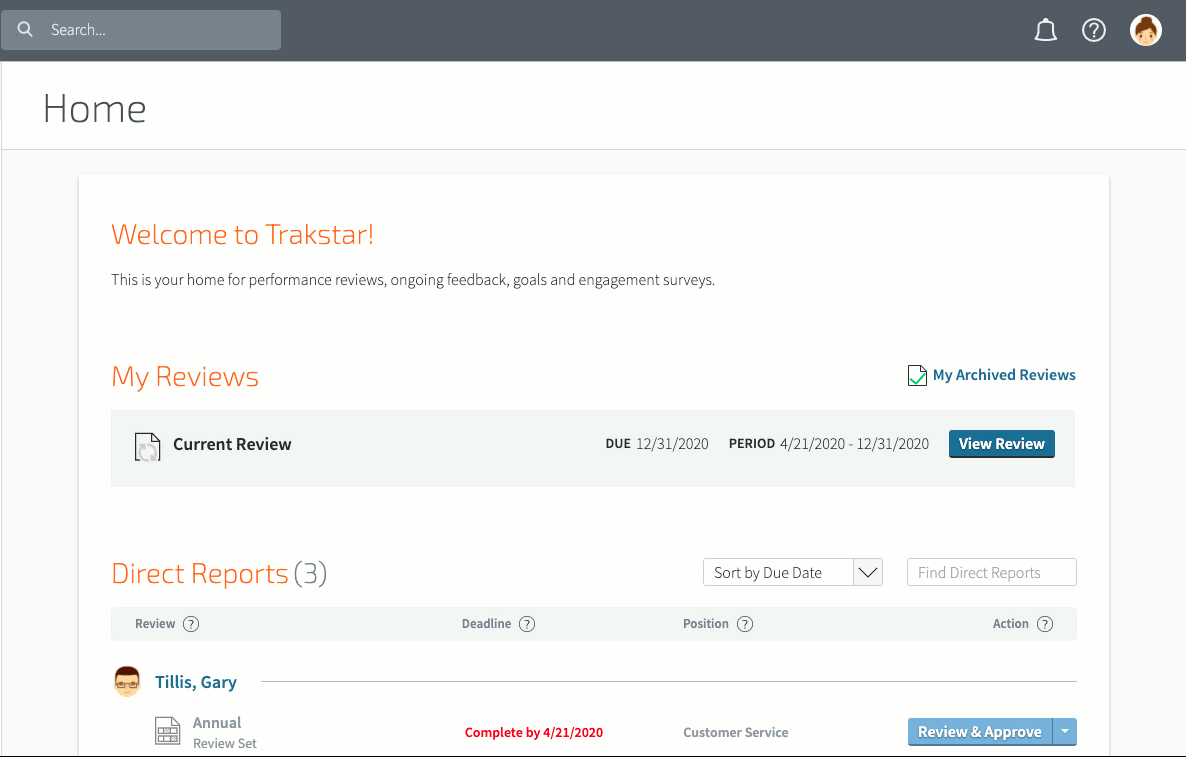Stack Ranking: Should Your Organization Use it in Employee Evaluations?
Posted by Dave • April 3, 2020 (Last modified March 17, 2021) • 7 min read
Using stack ranking, every employees’ performance review score is ordered and grouped. The group with the highest scores are deemed top performers. These are the employees who consistently exceed expectations and deliver better results than their peers. The largest portion of employees fall into the middle group and are considered adequate at their jobs—neither overly succeeding nor failing. And the group with the lowest scores are identified as under performers, who prevent the organization from operating at full capacity.
Stack ranking provides a big picture overview of performance across your workforce. You can use the data to inform compensation and succession planning. It can also be used to reassign employees, implement performance improvement plans, and, if necessary, terminate under performers.
However, being over-reliant on stack ranking is widely considered to be an outdated and overall negative performance management practice. In this blog post, you’ll learn how stack ranking came to be, why it fell out of favor, and the role it plays in the modern employee evaluation process.
The history of stack ranking
Stack ranking was popularized in the 1980s by General Electric CEO Jack Welch. GE managers were initially asked to rate their direct reports on a 1-to-5 scale. However, it resulted in the classic problem of managers overwhelming scoring employees a “3” (commonly referred to as the central tendency bias). So Welch responded by implementing a “20-70-10” stack ranking system.
Using this version of stack ranking, managers were required to group 20 percent of their direct reports as top performers, 70 percent as adequate performers, and 10 percent as under performers. The top performers were rewarded with promotions, raises, and bonuses, while the bottom 10 percent were unceremoniously fired without being given an opportunity to improve. The performance management practice became known as “rank and yank” within GE.
Despite the harsh management philosophy, GE thrived under Welch’s leadership. The company increased in market value from $12 billion in 1981 to $410 billion in 2001 when he retired. Today, he is remembered as one of the greatest business leaders ever and countless executives try to emulate his management style.
Stack ranking became widely used in the 1990s but its disadvantages became apparent. Years after Microsoft adopted the practice, a Vanity Fair profile described an unhealthy culture with dissatisfied employees and workplace politics. Employees were reluctant to collaborate out of fear that a colleague’s failure would reflect poorly on them. The profile also included anecdotes about employees taking credit for other people’s work and talking down about their peers behind closed doors. Stack ranking created an environment where everyone in the organization was jockeying for a favorable position against each other.
Microsoft abandoned the practice in 2013. It’s still used today by some organizations but others like Ford, Goldman Sachs, Adobe, and even GE all fall into the camp of companies that no longer use stack ranking.
Problems with stack ranking
There are obvious problems with stack ranking like employee performance being driven by fear and self-interest. The practice also doesn’t mesh with modern workplace cultures that value employee engagement, transparency, and collaboration.
Let’s take a deeper look at the concept and explore some of the other disadvantages it presents.
Employees become risk-averse
Most managers encourage employees to step out of their comfort zones and take ownership of work no one is responsible for. However, that can be a gamble when employees are evaluated with stack ranking. Taking a chance and failing could be detrimental to the employee’s career so it is often safer for them to focus on the work they’re familiar with.
Employees are motivated by self-interest
Employees support each other and work together in a healthy workplace. But when stack ranking lingers in the background, employees are inclined to focus on their own responsibilities and ignore a teammate in need.
Promotions can lead to failure
Stack ranking can deter top performers from wanting a promotion. If a great employee fears they’ll struggle in a new role, they can conclude they’re safer where they’re at. Especially, if that position is known to have a high turnover rate.
Employees exit on their own
Managing with fear just encourages employees to seek new opportunities at organizations with healthier cultures. Eventually, you’ll have to fill the positions that were vacated by low performers who were terminated and the talented employees who left on their own.
Trouble attracting new employees
As if high turnover wasn’t a big enough challenge, attracting qualified replacements is also difficult with a negative culture. In the era of social media and Glassdoor, employees can share their bad experiences online, discouraging talented job seekers from applying to your organization.
Can lead to workplace discrimination
The idea behind stack ranking is organizations make difficult choices based strictly on evaluation scores. In reality, the practice opens the door for biases to influence workforce management decisions. A handful of well-known companies have faced discrimination lawsuits because of the fallout from stack ranking.
Employees get forced into performance categories
No organization has a perfect 20-70-10 balance of top performers, adequate performers, and under performers. The ones that follow such parameters force managers to make tough—and sometimes unnecessary decisions—on who gets rewarded, who can continue as is, and who faces serious consequences.
Leads to operational issues
When organizations face high turnover, operations slow down when key positions are vacant. A sparse team can hinder a manager’s performance, who is included in the employee rankings like everyone else. If they’re motivated by self-interest, they may try to hire a replacement as quickly as possible, instead of taking the time to find the best person for the job.
When to use stack ranking
Even though stack ranking is ripe with disadvantages, it does have a place in performance management when used correctly. Segmenting employees by their performance review scores can help HR and leadership make fair and reasonable workforce decisions. Let’s review to properly use stack ranking after an evaluation cycle is complete:
- Conduct compensation planning – Top-performing employees should be rewarded with raises if it’s feasible for the organization. Pinpointing the employees with the highest evaluation scores makes it easy to allocate compensation increases.
- Determine promotions – Similarly, top performers should be given more responsibility to go along with their raise. However, promotions should be based on current performance and potential to do more so use a 9-box grid to help with succession planning.
- Create employee training programs – Top performers have knowledge and skills that should be shared with their colleagues. Stack ranking helps you determine who can create employee training programs that will elevate the performance of entire teams.
- Retrain underperformers – While it’s harsh to terminate under performers based on a single performance evaluation, stack ranking does help you uncover who needs additional guidance. You can provide them with education that will teach them a better approach to their job.
- Identify trends in the organization – Performance, good or bad, isn’t always solely on the employee. Stack ranking can be used to identify entire teams that are either exceeding or falling short of expectations.
Stack ranking fosters negativity across the organization when it’s used as the centerpiece for performance reviews. However, organizing employee scores is beneficial for completing post-evaluation action items, provided you don’t go too far with the results.
A modern approach to performance management
Stack ranking is a great way to get a quick glance at every employees’ evaluation score. However, it shouldn’t be the main driver of workforce planning. You should have a comprehensive performance review system so you accurately gauge how each employee is doing at their job and can help under performers get back on track.
We’ll wrap up with some quick tips for modern performance management:
- Set measurable employee goals – Assigning clear, measurable goals for every employee helps them understand exactly what they should focus on and guides their performance evaluation.
- Collect multi-rater feedback – Collecting feedback from the different people an employee works with prevents biases from influencing their final evaluation score.
- Provide employees frequent feedback – Encourage managers to meet with direct reports regularly to talk about what they’re doing well and where they can improve.
- Be aware of employee engagement – Engaged employees are consistently productive so always consider if your organization is doing everything it can to help team members meet their full potential.
- Use PIPs when necessary – A performance improvement plan (PIP) can be used to get an under performer improve before you take the drastic step of termination.
A stack ranking-focused evaluation process comes with too many downsides. Following the tips above promotes a healthy workplace where your employees are happy, productive, and receptive to the results of their performance review.
Don't Miss Out on More Great HR Articles!
Subscribe to get the latest, greatest HR and Talent Development content straight to your inbox.


